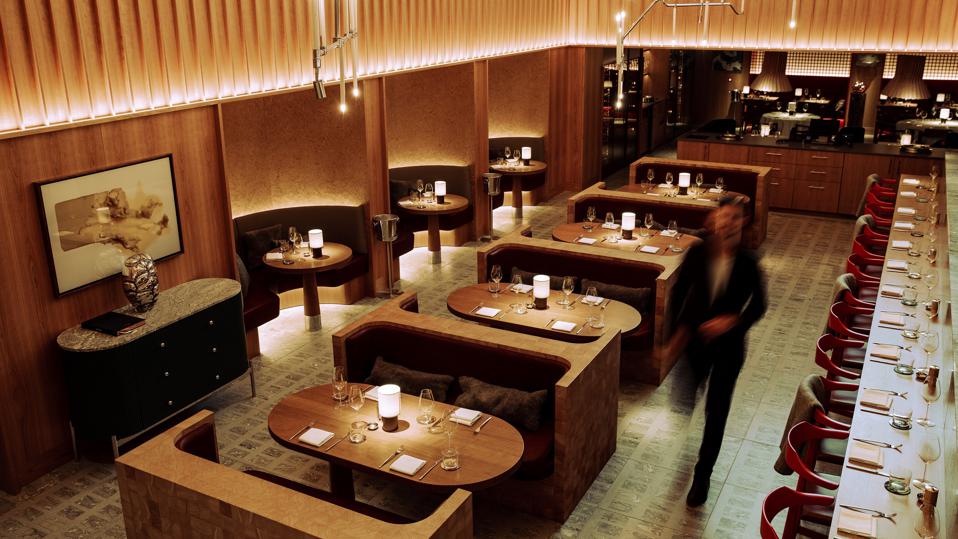Dining is not the first thing that comes to mind when consumers think of Harrods—despite its retail Food Halls being internationally famous. As one of the world’s top destinations for luxury, showcasing over 3,000 brands, the department store in Knightsbridge, London maintains a high-fashion image based on exclusivity and tailored service.
Even the retailer’s website is shy about the 26-strong restaurant and bar offer—you have to hunt around at the bottom to find the details. Yet eating and drinking in-store has blossomed to the extent that towards the end of last year it was trading 44% higher than it was pre-Covid, and transaction values were also 47% up on 2019. More widely, Harrods turned a profit again in the last financial year for which figures are available.
The latest addition to the roster of dining venues—which features fêted names like Jason Atherton, Vineet Bhatia, Tom Kerridge, Angelo Musa, Gordon Ramsay, and Em Sherif—arrived at the end of 2022. Studio Frantzén, brought another Michelin-starred chef to the store, this time from Sweden.
Björn Frantzén’s à la carte restaurant, with a signature Asian-influenced take on Nordic cuisine, is literally the pinnacle of Harrod’s dining experiences because it is found at the very top of the department store’s building on two floors, plus an outdoor terrace. The latter is claimed to be the only rooftop terrace in Knightsbridge and Mayfair, two of London’s most desirable districts. As well as being a choice for foodies, the 150-seat Studio Frantzén is open late and has a buzzy vibe with two bars, one of which offers sweeping views.
Data-led gains
So what is the attraction of having so many eating and drinking spots in the store? I had the chance to catch up with Harrods’ director of restaurants and kitchens, Ashley Saxton, to find out how for and beverage (F&B) is fast becoming a revenue driver and a cornerstone of the business.
“Our research has found that when customers engage with our restaurants they also engage more often with the store. They spend twice as long in the building and spend twice as much money,” he said.
That insight alone has given Saxton quite a bit of freedom to flex his empire. Some elements, like The Harrods Tea Rooms, were always a must-have for the store as it’s part of the Harrods brand DNA, much like Fortnum & Mason’s traditional afternoon tea in Piccadilly. Others have been the result of new research and hard graft.
Each spot must convert Harrods shoppers into diners. Then it becomes a virtuous circle of more shopping and more spending—and back to dining. At the outset, the most prolific spenders at the store were the least engaged with eating in, partly because the store had not drilled down into the needs of specific cohorts. Now, 80% of customers on Harrods Rewards card database are using restaurants, up from 29% pre-Covid.
“We’re a lot more knowledgeable about what our customer segments—different age groups and different nationalities for example—are looking for, and we’ve built our proposition around that. It is very much behavior-led,” said Saxton. From a conversion rate of 8% pre-Covid (ie the percentage of shoppers that decided to dine), this has risen to 20%.
The destination strategy
Another tack is to make restaurants a destination in themselves and Studio Frantzén is a good example of that. It acts as an entry point for local, affluent consumers from which to then discover the store and what the Harrods brand stands for. About 74% of all the F&B trade in the store is done before 4pm giving diners plenty of time to explore the various department afterward.
Thanks to its research, Harrods is seeing the restaurant business in a very different light. From merely being a place to refill and rest before resuming shopping, it’s now about destination dining. “It’s important that we see restaurants as a vehicle of the store’s future success,” said Saxton.
As well as the 26 restaurants located in the Harrods building, there are others, for example abroad, adding up to 45 in total. Some of these locations, mainly tea rooms, are in Shanghai, Qatar and Bangkok, in both downtown spots and also airports.
It has only been about three-and-a-half years since Harrods began to really drive its F&B business under Saxton’s lead. “When Covid arrived we could have battened down the hatches or use it to go to the market and talk about our plans for growth and development and our change of proposition,” he said.
The latter course was the correct one, with new-builds taking place during the pandemic downtime leaving the retailer in a strong position to capitalize on all the changes post-Covid. “Right now, experience is more important than product in driving people into retail environments and away from a dot.com. We are doing that through F&B,” said Saxton.
Food is capturing hearts and minds in the wider luxury sphere, too. Within Harrods, a Dior café has opened which acts as an entry point into the Dior fashion universe, much like brands have done with their accessories and fragrances. Another example is the Fendi café at Hamad Airport’s new luxury showcase in Qatar.
Saxton commented: “There is huge demand out there for these F&B-led experiences. We had almost 10,000 bookings made for the Dior café in the first four days of opening. If we take the Gen Z customer, they are telling us they want to spend their money on luxury, fashion, and dining. This combination is gold.”

